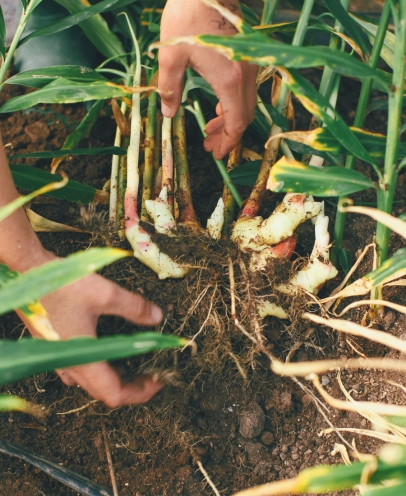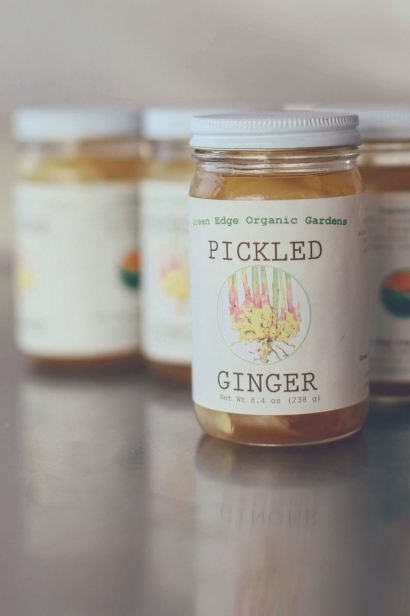Edible Ginger: How a Tropical Crop is Taking Root in Ohio Soils
Planted between rows of tomato plants and the complementary beds of basil, edible ginger (Zingiber officinale) looks like an escaped houseplant in hiding. While unaccustomed eyes may compare the plant’s appearance to a stunted stalk of corn, there is little else that it resembles in a Central Ohio garden. Ginger is still somewhat of a refugee in Ohio soils, not yet quite at home or established in our local-food landscape.
Long valued for its pungent flavor and medicinal properties, edible ginger has only relatively recently taken root on Ohio’s farms. Appropriately classified as young ginger, edible ginger grown in Ohio is harvested before the plant reaches full maturity. Preferring tropical or subtropical climates, edible ginger requires special treatment in Ohio—one of the reasons it is not commonly grown. Though technically the same plant as mature ginger, young Ohio ginger is vastly different from the thick-skinned, fibrous, dry root you’ll find in stores.
Instead, think pink—the color of the tops of the fresh ginger rhizomes where they connect to the stalk. Think crisp—the texture of a carrot. The skin of young ginger can be peeled off with your thumb. The rhizome retains moisture. It’s not what you’re used to.
Ginger in the Kitchen
Chef Tom Smith of The Worthington Inn says he’s missed having access to young, fresh ginger ever since he left Hawaii. Today he purchases fresh young ginger from Green Edge Organic Gardens in Amesville, Ohio. He describes the flavor of young ginger as more floral yet less assertive than mature ginger. He notes that young ginger is much easier to peel and that unlike mature ginger with its less appealing texture, there is no need to strain out the young ginger pieces after cooking. Tom uses young ginger in salsas and sauces for dishes at The Worthington Inn, though his favorite recipe is a homemade ginger ale using only a simple syrup, puréed young ginger, and soda water.
Michelle Kozak, proprietor and chef at Pâtisserie Lallier in Columbus, makes and sells organic ginger fruit candies from fresh ginger grown by Swainway Urban Farm in Columbus. Like many customers, Michelle buys and freezes the ginger to last throughout the year until the following harvest. Fresh young ginger can be processed before it is frozen, or stored as-is. While it doesn’t thaw well, frozen young ginger can be grated into dishes as needed and the remaining rhizome returned to the freezer.
On the Farm
Three years ago Natalie Horvath read an article about growing ginger in temperate climates and wondered if it could be done in Ohio. Green Edge, her employer, was already well established as an innovator in the local food community. The farm’s successful season extension model enables them to fill more than 150 community-supported agriculture (CSA) orders through the dead and cold of winter. From that starting point, exploring new crops that are only possible with an extended growing season is a logical next step. Green Edge now has several beds of young ginger planted each year, thanks to Natalie’s initial curiosity, and has since added turmeric root as well.
In Clintonville, ginger plants occupy every available row of garden space in Joseph Swain’s backyard. Not your typical image of a backyard garden, this backyard is one of the three locations that make up Swainway Urban Farm, a partnership between Joseph Swain and the Harmonious Homesteader, Rachel Tayse. Also an innovator in the local food community, Joseph explains that with only one acre of land in production, the farm’s success depends on being intentional in their production choices. Ginger, he says, fits the farm’s focus of growing niche and specialty crops.
The Risks & Rewards
As a new crop, young ginger offers new opportunities and new challenges for those growing it. Confronting high up-front costs, limited parameters for growing, and untested local markets, both Green Edge and Swainway have taken risks with ginger. One difficulty growing ginger in Ohio is that it requires a long period of maturation compared to a short window for harvesting. That window at Green Edge is early or mid-August until late September, when the summer beds need to be turned over to start planting crops for the winter. At Swainway, harvests can extend a little longer as long as there is no risk of freezing temperatures.
Faced with the challenge of a limited harvest season for a crop that customers were unfamiliar with, Green Edge started looking for ways to extend young ginger’s availability. Last year, the farm started producing and selling jars of pickled ginger. Natalie worked closely with the staff at the local business incubator, the Appalachian Center for Economic Networks, or ACEnet, to create the product. Having no prior experience with creating value-added products or bringing them to market, Natalie says that ACEnet’s help was instrumental in bringing local pickled young ginger to market shelves.
It is safe to assume that a generation ago no one would have expected to find fresh ginger locally and commercially available in Ohio; nor would one expect to purchase fresh locally grown lettuce on the coldest days of January. Tom says there was a time when it seemed like he couldn’t find anything that was locally grown—now, he says, he can find almost everything. “It takes a community effort,” he tells me.
Farmers, chefs, customers, businesses, and community advocates each play a role. And as farms like Green Edge and Swainway demonstrate, within that network of support innovation can take root. By extending the growing season and introducing new crops, our concept of foods that are local, sustainable, and organic is limited less by our geography, and more by our ideas of what is possible.
Ohio-grown, organic young ginger can be purchased at the following locations:
Columbus
Clintonville Farmers Market
Worthington Farmers Market
Bexley Natural Market
Clintonville Community Market
Little Eater Produce and Provisions (at North Market)
Athens
Athens Farmers Market
The Farmacy
The Village Bakery
Learn more about Ohio Ginger at The Seasoned Farmhouse











